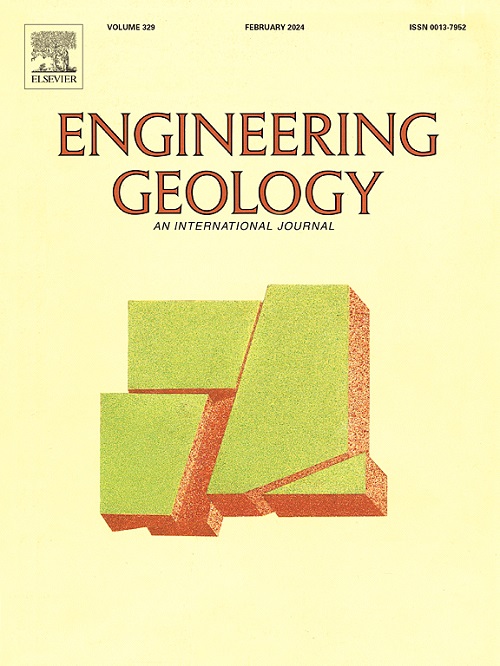慢滑机制概念模型的多源数据分析:在道尼亚亚平宁地区皮亚内洛山坡上的应用
IF 8.4
1区 工程技术
Q1 ENGINEERING, GEOLOGICAL
引用次数: 0
摘要
在边坡尺度上对滑坡过程进行彻底的诊断是设计和实施有效和可持续的缓解措施的前提。本文描述了一种已发表的滑坡危险性评估的分阶段方法学方法的第一阶段现象学阶段的高级应用。本应用程序旨在通过整合基于大量跨学科、多源数据的不同主题模型,推导出滑坡机制的概念模型,同时对先前提出的方法进行系统化和微调。所采用的工作流程特别容易通过数字工具实施,这将促进滑坡和其他岩土工程过程的概念和数值建模过程,特别是在复杂的地质-水力-机械环境中。该方法应用于亚平宁山脉东南部的一个城市化遗址,Bovino镇的Pianello山坡,这是一个典型的案例,代表了许多其他受结构复杂的古代缓慢移动山体滑坡影响的遗址。斜坡的特点是复杂的地质构造和水文地质环境,以及高度不均匀的、高度构造化的土壤,由嵌入在主要粘土基质中的断裂岩层组成。对于试验场地,低抗剪强度(既有固有抗剪强度,也有先前剪切引起的抗剪强度)和高压头被认为是导致边坡破坏的内在因素。除了坡脚处河流的侵蚀作用外,现有滑坡的重新激活可归因于高累积降雨量在季节时间尺度上引起的深层孔隙水压力振荡。通过对不同模型和数据的整合,研究强调了影响滑坡活动的诱发因素和触发因素之间的相互作用与地质-水-力学环境的复杂性密切相关。通过将该方法先进地应用于皮亚内洛山坡的原型案例,对深层缓慢移动的滑坡过程的洞察可以很容易地推广到类似的地质-水力力学背景下的许多其他案例。本文章由计算机程序翻译,如有差异,请以英文原文为准。
Multi-source data analysis for conceptual modelling of slow landslide mechanisms: Application to the Pianello hillslope in the Daunia Appenines
A thorough diagnosis of landslide processes at the slope scale is the prerequisite for the design and implementation of effective and sustainable mitigation measures. This paper describes the advanced application of the first, phenomenological stage of an already published stagewise methodological approach for landslide hazard assessment. The presented application aims at deriving the conceptual model of landslide mechanisms through the integration of different thematic models built upon big sets of cross-disciplinary, multi-source data, while providing the systematization and fine-tuning of the previously proposed methodology. The employed workflow is particularly apt to be implemented through digital tools that would boost the process of conceptual and numerical modelling of landslides and other geotechnical processes, particularly in complex geo-hydro-mechanical contexts.
The methodology is applied to an urbanised site in the Southeastern Apennines, the Pianello hillslope in the town of Bovino, a prototype case representative of many other sites affected by ancient slow-moving landslides in structurally complex formations. The slopes are characterized by a complex geo-structural and hydro-geological setting, and by a highly heterogeneous, heavily tectonised soil, composed of fractured rock layers embedded in a predominant clayey matrix.
For the test site, low shear strength, both intrinsic and induced by previous shearing, and high piezometric heads, are recognized as internal factors predisposing the slope to failure. Besides the erosion exerted by the stream at the toe of the hillslope, the reactivation of existing landslides is ascribed to porewater pressure oscillations at depth, induced by high cumulative rainfall over a seasonal timescale. Thanks to the integration of different models and data, the study highlights that the interplay between predisposing and triggering factors influencing the landslide activity is strongly related to the complexity of the geo-hydro-mechanical setting. The insight into deep slow-moving landslide processes acquired through this advanced application of the methodology to the prototype case of the Pianello hillslope can be easily generalised to many other cases in similar geo-hydro-mechanical contexts.
求助全文
通过发布文献求助,成功后即可免费获取论文全文。
去求助
来源期刊

Engineering Geology
地学-地球科学综合
CiteScore
13.70
自引率
12.20%
发文量
327
审稿时长
5.6 months
期刊介绍:
Engineering Geology, an international interdisciplinary journal, serves as a bridge between earth sciences and engineering, focusing on geological and geotechnical engineering. It welcomes studies with relevance to engineering, environmental concerns, and safety, catering to engineering geologists with backgrounds in geology or civil/mining engineering. Topics include applied geomorphology, structural geology, geophysics, geochemistry, environmental geology, hydrogeology, land use planning, natural hazards, remote sensing, soil and rock mechanics, and applied geotechnical engineering. The journal provides a platform for research at the intersection of geology and engineering disciplines.
 求助内容:
求助内容: 应助结果提醒方式:
应助结果提醒方式:


